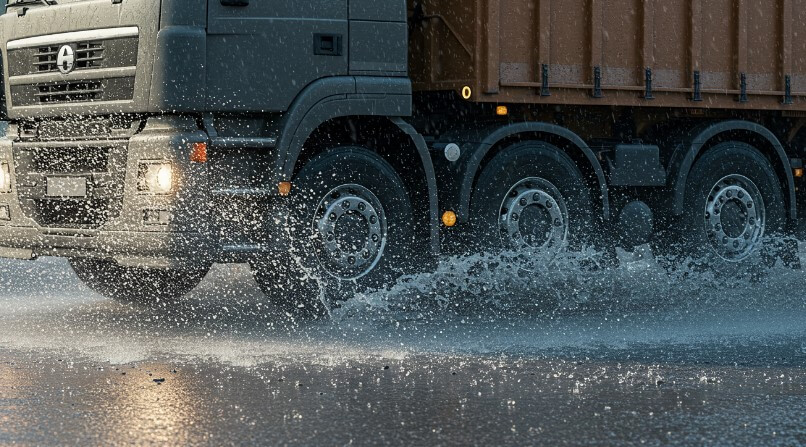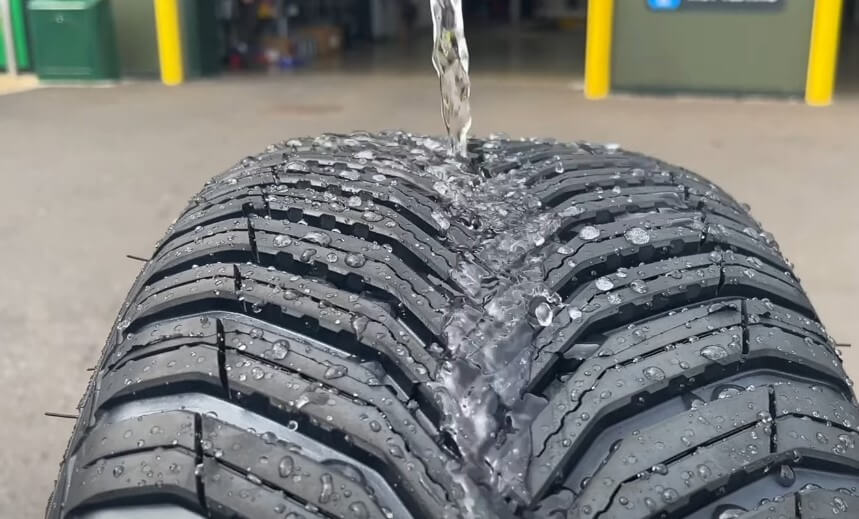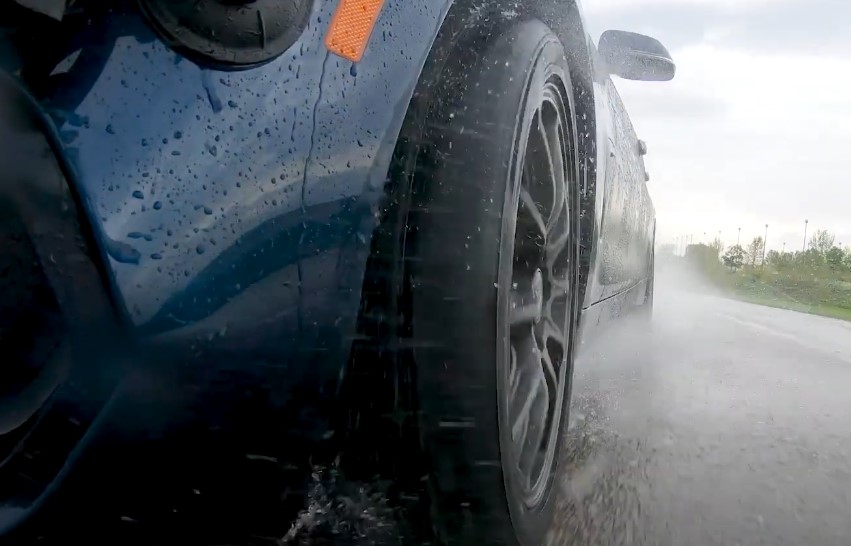Rainy weather changes how your vehicle behaves. Water on the road reduces friction, lengthens stopping distances, and can make even the most predictable car feel unsettled.
According to the Federal Highway Administration (part of the U.S. DOT), each year, 75% of all weather-related vehicle crashes occur on wet pavement, and 47% happen during rainfall. The reason is simple: water affects both traction and driver response.
The gap in stopping distance between a fresh tire and one worn to half its tread depth can range from 14 to 31 feet, depending on the model. Even among brand-new tires, wet braking distances can differ by nearly 50 feet between the best and worst performers. That’s three car lengths you might not have in an emergency.
The good news? In 2025, tire technology has made huge strides in wet-road safety. You still need to choose carefully – not every model is built for the same conditions – but with the right match for your vehicle, climate, and driving style, you can keep control even when the skies open up.
Why Wet Road Performance Matters

Wet driving conditions demand more from your tires. The difference between holding the line through a curve and sliding wide often comes down to how quickly water is cleared from under the tread. Two main issues are at play:
- Hydroplaning risk: When water builds up faster than the tire can push it away, the tread loses contact with the asphalt.
- Reduced braking efficiency: Even without hydroplaning, water creates a thin barrier that lowers grip, forcing you to brake earlier.
In heavy rain, both can happen quickly – especially if your tires are worn or poorly suited to wet conditions.
The Key Factors That Affect Wet Grip
If you’re shopping for new tires in 2025, focus on a few critical design elements. They aren’t just marketing buzzwords – they directly affect how well your tires perform when the road turns slick.
Tread Pattern
Deep, continuous grooves running around the circumference of the tire are essential. They channel water away from the contact patch, reducing hydroplaning risk. Wide, open channels tend to perform best in heavy rain.
Rubber Compound
The mix of materials determines flexibility and grip. A high-silica compound stays pliable in cooler, wetter weather, improving adhesion. The trade-off? These compounds sometimes wear faster in hot, dry conditions.
Contact Patch Size
A slightly narrower footprint can help in the rain by increasing the pressure on the road surface, allowing water to escape more quickly. That’s why some all-season and winter tires do well in wet conditions.
Siping
Sipes are tiny slits in the tread blocks. They act like small edges that bite into the water film on the road. Modern 3D sipes even lock together under pressure to maintain block stability during cornering.
Using UTQG Ratings for Clues
The Uniform Tire Quality Grading system offers insight into wet performance:
- Traction Rating: Ranges from AA (best) to C. This is specifically about wet stopping ability.
- Temperature Rating: Higher ratings (A or B) indicate the tire can handle heat without losing consistency – useful if rain comes after hot, dry stretches.
- Treadwear Number: Higher numbers mean longer life, though sometimes at the cost of ultimate wet grip.
Tire Types for Wet Conditions
Different categories of tires excel in different situations. Your choice should depend on where you drive and the kind of weather you encounter most.
| Tire Type | Wet Weather Strengths | Best For |
| Summer (Performance) | Outstanding grip in warm, wet weather; excellent water evacuation | Mild climates with frequent rain above 45°F |
| All-Season | Balanced performance across dry, wet, and light snow; affordable | Areas with mixed but moderate weather |
| All-Weather | Three-Peak Mountain Snowflake certified; strong in both snow and rain | Unpredictable climates with legal winter tire requirements |
| UHP All-Season | Sharp steering, high-speed wet stability | Sports sedans and performance cars |
| Winter | Deep treads and soft rubber work in cold rain and slush | Cold, wet winters (replace in warmer months) |
Features to Prioritize in 2025

If wet performance is your priority, pay attention to:
- Four or more wide circumferential grooves for maximum water evacuation.
- 3D sipes for grip during cornering without losing stability.
- Hydroplaning resistance ratings from independent tests.
- Adaptive compounds that adjust to temperature for consistent wet performance.
- Load and speed indexes that match your vehicle’s requirements are essential. Manufacturers from Austria such as HubTrac provide detailed specs to help ensure a perfect match.
Standout Wet-Weather Tires in 2025
Based on independent tests, driver feedback, and industry reviews, here are some of the best choices for wet roads this year:
Michelin CrossClimate 2
- Category: All-weather
- Why it stands out: Short wet braking distances, responsive steering, and snow capability.
- Price: ~$232 per tire, 60,000-mile warranty.
Pirelli Cinturato WeatherActive
- Category: All-weather
- Why it stands out: Excellent hydroplaning resistance (up to 79 km/h in tests) and competitive pricing.
Michelin Pilot Sport 4
- Category: Summer performance
- Why it stands out: High-silica compound with precise handling in heavy rain.
Continental ExtremeContact DW
- Category: Ultra-high-performance all-season
- Why it stands out: SportPlus Technology for wet grip and year-round consistency.
Bridgestone Potenza RE980AS
- Category: UHP all-season
- Why it stands out: Stable braking with 3D siping and solid wet cornering.
Other strong contenders include the Goodyear Eagle F1 Asymmetric 5, Pirelli P Zero All Season Plus, Yokohama Advan Sport A/S, Toyo Proxes 4 Plus, Nokian zLine A/S, Dunlop Sport Maxx RT 2, and Hankook Ventus V12 evo2.
Testing Data and Performance Gaps

Independent tests in 2025 reveal significant differences between top-tier and budget tires.
- Car and Driver found the Michelin CrossClimate 2 topping wet performance in their BMW 330i test.
- Tyre Reviews measured a 10-meter difference in wet braking between the best all-season tire and a budget competitor.
- Continental AllSeasonContact 2 scored the fastest wet handling lap time, while cheaper models trailed by over 22 seconds.
The takeaway: premium tires consistently outperform in wet conditions – often by a margin that matters in real emergencies.
Maintenance for Wet-Road Safety
No matter how good your tires are, they’ll only perform well if they’re in top condition.
- Tread Depth: Replace before reaching the 2/32-inch legal minimum. For wet safety, many experts recommend 4/32 inches.
- Proper Inflation: Keeps the contact patch optimal and prevents uneven wear.
- Rotation and Alignment: Regular service ensures all tires wear evenly, preserving wet performance.
- Visual Checks: Look for cuts, bulges, or embedded debris that could cause blowouts in rain.
Driving Tips When It’s Wet
View this post on Instagram
Even with the best tires, technique matters:
- Reduce speed and avoid sudden steering or braking inputs.
- Increase following distance to at least four seconds.
- Stay in the tracks of the car ahead to benefit from partial water clearing.
- If hydroplaning begins, ease off the accelerator and steer straight until traction returns.
Final Words
Choosing the best tires for wet roads in 2025 comes down to matching your driving environment with the right technology. Look for strong hydroplaning resistance, high wet traction scores, and proven test results.
If you live in a rainy climate, consider investing in all-weather or high-performance summer tires with advanced tread designs and high-silica compounds. For mixed conditions, quality all-season tires still offer excellent safety with the convenience of year-round use.
The right set not only improves your safety but also makes wet-weather driving less stressful. In a world where a few feet of stopping distance can make all the difference, it’s a choice worth making carefully.
